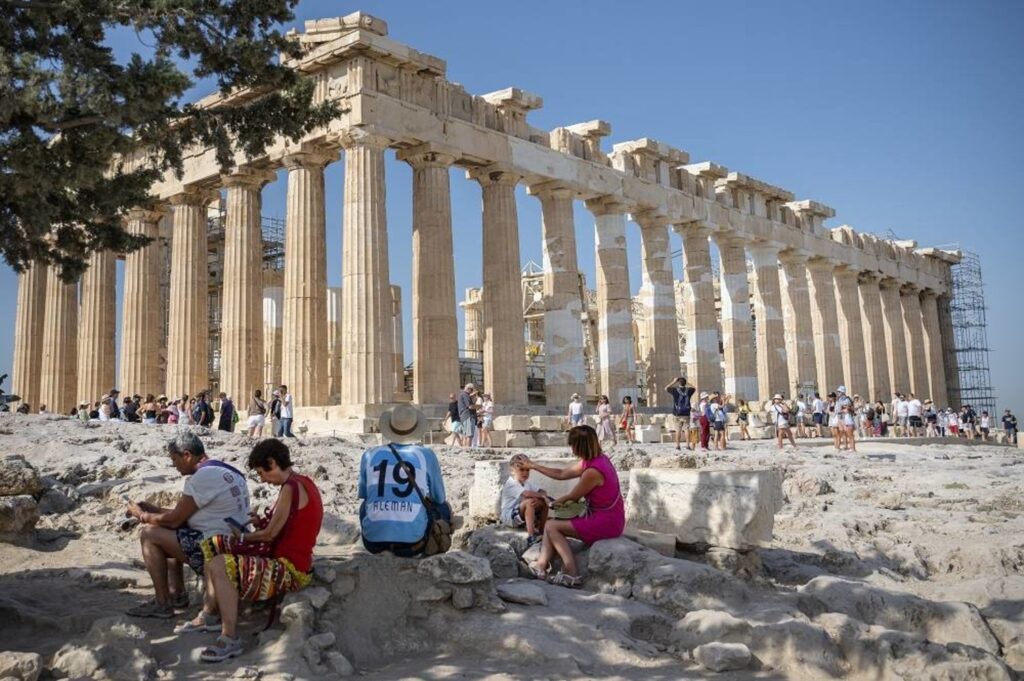First-aid workers drafted in to treat visitors suffering effects of 48C – 118F –temperatures at the country’s most visited monument
The Greeks know a thing or two about heat, and they know a thing or two about dealing with it. But last week saw heat of an altogether different order.
Temperatures were of such magnitude that they called for measures never before seen in a country that prides itself on being the first in Europe to have appointed an official dedicated solely to dealing with the challenges of global heating.
And so it was that at noon on Friday the Acropolis was closed in the name of “protecting” visitors from the sun. There would be other steps, both unprecedented and bold. Volunteers with the Hellenic Red Cross had been seconded to distribute free bottles of water, first-aid rescue workers had been dispatched to the site, and shading had been erected at the main entrance to the Golden Age temples. It was hoped the media could inform foreigners because it was a “very difficult” day.
In what would be the hottest day of the year – with the mercury hitting 45C (113F) in Syntagma Square and likely reaching 48C (118F) on the rocky outcrop on which the Acropolis stands – “difficult” soon resembled a war footing at the base of Greece’s most visited monument.
By noon, 30,000 water bottles had been handed out – the fruit of donations to the Red Cross; men, women and children who had either collapsed or fainted had received first aid in field tents; and some 11,000 visitors had filed through the fifth-century BC wonder, frequently escorted by guides entreating them to “move faster” to escape temperatures seen as the invisible enemy.
By 8pm, when the gates to the site were closed, almost twice that number had made the gruelling ascent. Among them on Friday was Annali Kemp with her two teenage children and husband, Steve, who baulked when she saw the queues and came close to leaving before being “spurred on” by her family to stay.
“To think it’s only mid-July and we’ve got August to come,” said the 53-year-old Briton, visibly red-faced after the exertions of the climb. “We were squished like sardines at some point up there but it’s a once-in-a-lifetime experience.
“We now live in New Zealand where there are no antiquities, so you put up with the heat, and God was it hot, so hot that for the first time – and please feel free to write this – I didn’t have any hot flushes.”
In an economy as tourist dependent as that of Greece, it is clear the state is taking no chances. The prospect of Iraq-like temperatures causing havoc at one of its symbols of democracy is a risk no Athens government is willing to take when attracting record visitor numbers is on the minds of policymakers.

“We were in Rome on Wednesday and the heat was brutal but there were none of these measures,” said Leo Grafstein, an American doctor conducting a whirlwind tour of Europe with his family. “At the Colosseum, even the guides were saying there should be some shade.”
ut while mainland Europe’s southernmost capital has thought outside of the box to cope with the scourge of extreme heat – with Greek scientists naming and categorising heatwaves to raise awareness and preparedness to avert loss of life – it is a battle with no end in sight. The Hellenic National Meteorological Service said that from today the intensity of the heat is expected to decrease, but from Thursday temperatures will start to rise again and a new heatwave will be felt in most parts of the country.
Up at the Acropolis, the realities of the climate emergency were on full display as it becomes ever more evident that the future will be fraught with difficulty as humans and urban environments attempt to adapt to temperatures accelerating with a speed few had envisaged.
By 9pm on Friday, the Greek culture ministry announced that the ancient sanctuary would be closed on Saturday – only this time earlier than on Friday “because the stones and marbles have now absorbed so much heat”.
As the sun set over the Attic sky, a ball of orange-red, it was hard not to think of 2050 when weather people predict temperatures will likely have risen by as much as 2.5C.
It was a flash of colour and the harbinger of the future, after a day in which the light had trembled with the ferocity of a heat the ancients would have flinched at; a beautiful sunset that, short of urgent action, spells menace ahead.
Source: The Guardian


